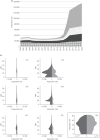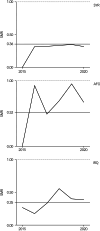Suicide among post-Arabellion refugees in Germany
- PMID: 39450528
- PMCID: PMC11698212
- DOI: 10.1192/bjo.2024.755
Suicide among post-Arabellion refugees in Germany
Abstract
Background: Although immigrants are considered to be vulnerable to mental illness, there is limited knowledge regarding their suicide mortality.
Aims: To investigate standardised mortality ratios (SMR) for suicide among the largest immigrant populations in Germany before and after the refugee movement of 2015.
Method: Data on immigrants and the general population in Germany between 2000 and 2020 were provided by the scientific section of the Federal Statistical Office. SMR with 95% confidence intervals were calculated by indirect standardisation for gender, age and calendar year for the pre-2015 and post-2015 time interval, first for all the immigrant populations studied and second for the Syrian, Afghan and Iraqi populations separately.
Results: Immigrants from the countries studied showed a lower suicide risk compared with the German reference population (SMR = 0.38, 95% CI = 0.35-0.41). No differences in SMR were found between pre- and post-2015 time intervals, in either the aggregate data for all populations or the data for Syrian, Afghan and Iraqi populations. Post-2015, Afghan immigrants (SMR = 0.68, 95% CI = 0.54-0.83) showed a higher SMR than Syrians (SMR = 0.30, 95% CI = 0.25-0.36) or Iraqis (SMR = 0.37, 95% CI = 0.26-0.48).
Conclusions: Despite the many and varied stresses associated with flight, comparison of the pre- and post-2015 time intervals showed that the suicide risk of the populations studied did not change and was considerably lower than that of the German reference population. We attribute this to lower suicide rates in the countries of origin but also to flight-related selection processes that favour more resilient individuals.
Keywords: Arabellion and Arab Spring; Germany; Suicide; flight; immigration.
Conflict of interest statement
None.
Figures




Similar articles
-
Suicide among immigrants in Germany.J Affect Disord. 2020 Sep 1;274:435-443. doi: 10.1016/j.jad.2020.05.038. Epub 2020 May 20. J Affect Disord. 2020. PMID: 32663973
-
Health condition of Afghan refugees residing in Iran in comparison to Germany: a systematic review of empirical studies.Int J Equity Health. 2023 Jan 21;22(1):16. doi: 10.1186/s12939-023-01832-7. Int J Equity Health. 2023. PMID: 36681845 Free PMC article.
-
Suicide and external mortality pattern in a cohort of migrants from the former Soviet Union to Germany.J Psychiatr Res. 2015 Apr;63:36-42. doi: 10.1016/j.jpsychires.2015.02.020. Epub 2015 Mar 3. J Psychiatr Res. 2015. PMID: 25770349
-
[SENTIERI - Epidemiological Study of Residents in National Priority Contaminated Sites. Sixth Report].Epidemiol Prev. 2023 Jan-Apr;47(1-2 Suppl 1):1-286. doi: 10.19191/EP23.1-2-S1.003. Epidemiol Prev. 2023. PMID: 36825373 Italian.
-
Differences in all-cause and cause-specific mortality due to external causes and suicide between young adult refugees, non-refugee immigrants and Swedish-born young adults: The role of education and migration-related factors.PLoS One. 2022 Dec 20;17(12):e0279096. doi: 10.1371/journal.pone.0279096. eCollection 2022. PLoS One. 2022. PMID: 36538535 Free PMC article.
References
-
- Grandi F. Global Trends, Forced Displacement in 2019. United Nations High Commissioner for Refugees, 2020. (chrome-extension://efaidnbmnnnibpcajpcglclefindmkaj/https://www.unhcr.or...).
-
- UNHCR. Global Trends: Forced Displacement in 2022. UNHCR, 2023. (https://www.unhcr.org/global-trends-report-2022).
-
- United Nations High Commissioner for Refugees (UNHCR) (2016). Global Trends: Forced Displacement in 2015. UNHCR, 2016 (chrome-extension://efaidnbmnnnibpcajpcglclefindmkaj/https://www.unhcr.or...).
-
- Federal Statistical Office (Destatis) Germany. Foreigner Statistics (Code:12521), 2022.
LinkOut - more resources
Full Text Sources

